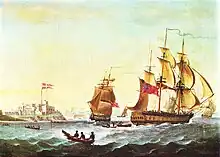Thomas Parr (slave trader)
Thomas Parr (1769–1847) was a member of an extended family of Liverpool merchants, developing his business as an English slave trader who profited from the Atlantic slave trade[2] to establish himself as "‘a merchant of great eminence in Liverpool".[3]

Career
Thomas Parr was born on 4th November 1769, the son of John Parr, gunmaker of Frederick Street, Liverpool, by his wife Hannah Anderton.
In subsequent years, he invested in at least 30 slave voyages. One of the slave ships that he had built for the trade in enslaved people, Parr, exploded on her maiden voyage. A street in Liverpool where he built a warehouse is named after him.
Slave trade

.jpg.webp)
Parr invested in at least 30 slave voyages,[4] and was sole owner of several ships:
| Vessel | No. of complete voyages for Parr | Notes |
|---|---|---|
| Amazon | 2 | 1783: renamed to Dumfries[5] |
| Argyle | 1 | 1807: legally started a slave voyage after the slave trade had been made illegal[6] |
| Expedition | 5 | 1808: condemned at Antigua as unseaworthy[7] |
| Hector | 2 | 1804: captured by the French[8] |
| Lovely Lass | 0 | 1798: foundered off Cape Lopez, Africa, all Africans lost[9] |
| Nile | 2 | 1803: became a Privateer[10] |
| Parr | 0 | 1798: the largest slaver in the British Atlantic, exploded near West Africa on first voyage[11] |
| William | 1 | Captured from the Spanish[12] |
Personal life

Parr built a house at Colquitt Street in Liverpool in 1797, that has been described as "magnificent".[13] The south wing of the house was a counting house. The house is flanked by pavilions, with one of them being used as a coach house. There was also a courtyard, a pleasure garden, a pond, and walks. The house was used between 1817 and 1948 as Liverpool Royal Institution; many of the people that established the institution were former slave traders.[13]
.jpg.webp)
Behind the house he built a warehouse that he used to store iron goods that were traded for slaves. The warehouse was five storeys high with a basement, with seven window bays to the south elevation and three to the east and west, each bay with ashlar lintels and stone sills. A passage led from the warehouse to the counting house.[13]
Retirement
Parr sold his Liverpool home around 1805 and retired to a country house and estate called Lythwood Hall, near Bayston Hill in Shropshire.[14] He became part of the landed gentry and acquired a notable collection of rare coins.[15] The acclaimed evolutionary scientist Charles Darwin met him in 1840, and described him as "an old, miserly squire".[13][16]
Legacy
Parr Street in Liverpool is named after him. Both his former home on Colquitt Street, Liverpool and his warehouse on Parr Street are listed with Historic England.[13][17] His former home at Lythwood Hall in Shropshire was demolished but there is a memorial to him in Lythwood.[18]
References
- "Utrolig historie: Orkaner, sørøvere og mytteri med 700 slaver om bord". ugeavisen.dk (in Danish). 18 March 2019.
- "Liverpool & the North West – Slave Traders & Plantation Wealth | Historic England". historicengland.org.uk.
- The Patrician, 1847, page 593
- "Thomas Parr – Liverpool Black History Research Group". 26 May 2021.
- Lloyd's Register (1783), Seq.№A130.
- Trans Atlantic Slave Trade Database – Argyle voyage #80347
- Trans Atlantic Slave Trade Database – Expedition voyage #81332
- "The Marine List". Lloyd's List. No. 4450. 4 May 1804. hdl:2027/mdp.39015005721504. Retrieved 18 September 2021.
- "The Marine List". Lloyd's List (3014). 26 June 1798.
- "Letter of Marque, p.80 – accessed 25 July 2017" (PDF). Archived from the original (PDF) on 20 October 2016. Retrieved 27 October 2018.
- Rediker, Marcus (2007). "Chapter 2". The Slave Ship: A Human History. U.K.: Viking.
- Trans Atlantic Slave Trade Database – William voyage #84043
- "No. 57, PARR STREET, Non Civil Parish – 1292976 | Historic England". historicengland.org.uk.
- https://www.thedicamillo.com/house/lythwood-park-lythwood-hall/
- See Burke's Landed Gentry, sub ‘Parr of Lythwood’, 1847, 2, 1003–4
- "The slavers and abolitionists on Liverpool's streets". BBC News. 15 January 2020.
- "ROYAL INSTITUTION, Non Civil Parish – 1206238 | Historic England". historicengland.org.uk.
- "Read the Signs – Street Names in Liverpool Connected to the Trade in Enslaved Africans | Historic England". historicengland.org.uk.